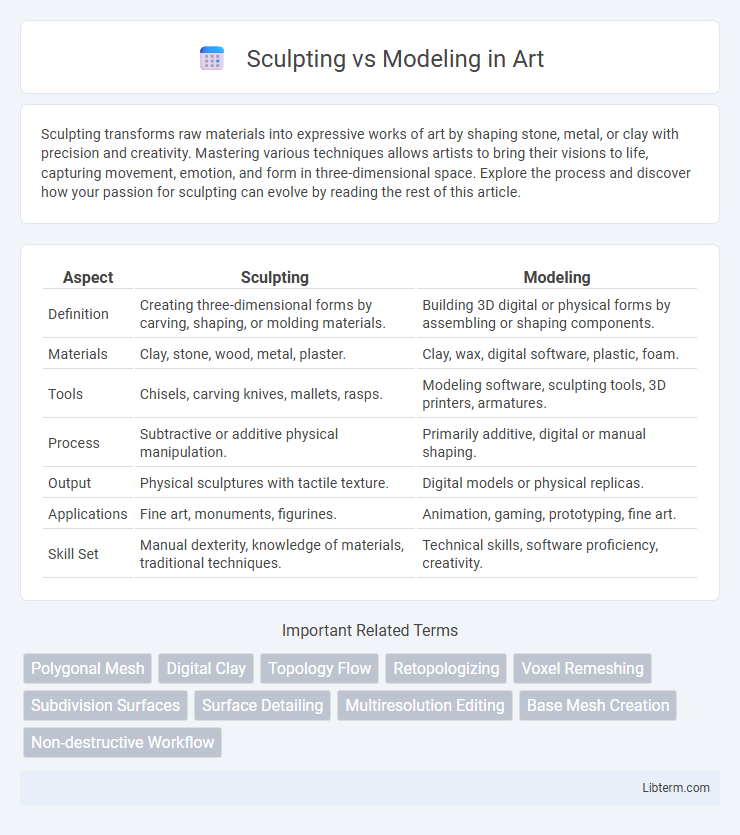Sculpting transforms raw materials into expressive works of art by shaping stone, metal, or clay with precision and creativity. Mastering various techniques allows artists to bring their visions to life, capturing movement, emotion, and form in three-dimensional space. Explore the process and discover how your passion for sculpting can evolve by reading the rest of this article.
Table of Comparison
| Aspect | Sculpting | Modeling |
|---|---|---|
| Definition | Creating three-dimensional forms by carving, shaping, or molding materials. | Building 3D digital or physical forms by assembling or shaping components. |
| Materials | Clay, stone, wood, metal, plaster. | Clay, wax, digital software, plastic, foam. |
| Tools | Chisels, carving knives, mallets, rasps. | Modeling software, sculpting tools, 3D printers, armatures. |
| Process | Subtractive or additive physical manipulation. | Primarily additive, digital or manual shaping. |
| Output | Physical sculptures with tactile texture. | Digital models or physical replicas. |
| Applications | Fine art, monuments, figurines. | Animation, gaming, prototyping, fine art. |
| Skill Set | Manual dexterity, knowledge of materials, traditional techniques. | Technical skills, software proficiency, creativity. |
Introduction to Sculpting and Modeling
Sculpting involves shaping a three-dimensional object by manipulating a virtual substance, often used to create highly detailed and organic forms through digital clay-like techniques in software like ZBrush or Blender. Modeling focuses on constructing 3D objects by defining vertices, edges, and faces, utilizing polygonal or NURBS methods primarily in applications such as Autodesk Maya or 3ds Max. Both techniques are essential in 3D asset creation, with sculpting emphasizing intricate surface detail and modeling prioritizing precise geometric structure.
Key Differences Between Sculpting and Modeling
Sculpting involves manipulating a digital or physical medium to add or subtract material, creating highly detailed, organic shapes with a focus on texture and form. Modeling uses polygonal structures to build objects from a mesh framework, emphasizing control over topology and precision in geometry. Sculpting excels in artistic freedom and detail, while modeling prioritizes technical accuracy and compatibility with animation pipelines.
Tools and Software Used in Sculpting
Sculpting in digital art primarily utilizes software such as ZBrush, Mudbox, and Blender's sculpting mode, designed to simulate real-world clay manipulation through brushes and dynamic tessellation. These tools provide advanced features like dynamic subdivision, voxel remeshing, and multi-resolution mesh editing, enabling artists to create highly detailed and organic shapes with precision and flexibility. Unlike traditional polygon modeling software such as Maya or 3ds Max, sculpting software focuses more on intuitive, freeform workflows that prioritize artistic expression and fine detail refinement.
Tools and Software Used in Modeling
Modeling in 3D design primarily utilizes software such as Autodesk Maya, Blender, and 3ds Max, which offer precise polygonal, NURBS, and spline-based tools for creating detailed mesh structures. These programs enable artists to manipulate vertices, edges, and faces to construct complex forms with high accuracy, supporting workflows ranging from low-poly game assets to high-resolution film production models. In contrast to sculpting's emphasis on organic shapes and dynamic brush strokes, modeling software tools prioritize exact measurements, topology control, and parametric modifications essential for engineering and animation-ready assets.
Workflow and Techniques Comparison
Sculpting emphasizes dynamic, organic workflows using digital brushes to shape high-resolution meshes, ideal for intricate details and natural forms. Modeling utilizes precise vertex manipulation, edge loops, and polygonal structures, enabling control over topology for animation-ready assets. The sculpting workflow supports iterative refinement with subdivision levels, while modeling relies on exact measurements and mesh optimization techniques for efficient rendering.
Artistic Flexibility: Sculpting vs Modeling
Sculpting offers unparalleled artistic flexibility through its intuitive manipulation of digital clay, enabling artists to create highly detailed, organic shapes with natural variations. Modeling relies on precise geometric control, allowing for structured designs but often limiting spontaneous creativity compared to sculpting. The choice between sculpting and modeling depends on whether an artist prioritizes fluid expression or exact structural accuracy in their creative process.
Application in Game Design and Animation
Sculpting in game design and animation excels at creating high-resolution, detailed character assets with intricate textures and organic shapes, offering artists fine control over surface anatomy. Modeling is essential for building low-poly, optimized meshes that ensure real-time performance and efficient rigging for animation pipelines. Both techniques integrate in workflows where sculpted details are baked into normal maps applied to modeled geometry to balance visual fidelity and computational efficiency.
Speed and Efficiency: Which Is Faster?
Sculpting offers rapid organic shape creation with intuitive brush strokes, making it ideal for detailed and expressive designs, while modeling uses precise vertex and polygon manipulation suited for structured objects. In terms of speed, sculpting accelerates concept development and iterative refining, but modeling provides greater efficiency in producing low-poly assets for real-time applications. The choice depends on project requirements, with sculpting favoring artistic freedom and modeling prioritizing optimized geometry and polygon count.
Choosing the Right Approach for Your Project
Sculpting excels in creating organic, highly detailed, and expressive 3D models, making it ideal for characters, creatures, and intricate surfaces. Modeling, especially polygonal modeling, offers precise control for hard-surface objects, architecture, and mechanical designs, providing efficiency in creating clean topology and animation-ready meshes. Choosing the right approach depends on project requirements, desired level of detail, and intended use within animation, gaming, or 3D printing pipelines.
Future Trends in 3D Sculpting and Modeling
Future trends in 3D sculpting and modeling emphasize the integration of AI-driven tools that enhance precision and speed, enabling artists to create highly detailed digital assets with less manual effort. Real-time collaboration platforms and cloud-based computing are becoming standard, allowing seamless teamwork and access to powerful rendering resources from anywhere. Advances in VR and AR technologies are also transforming workflows, providing immersive sculpting experiences that bridge the gap between physical and digital creation environments.
Sculpting Infographic

 libterm.com
libterm.com